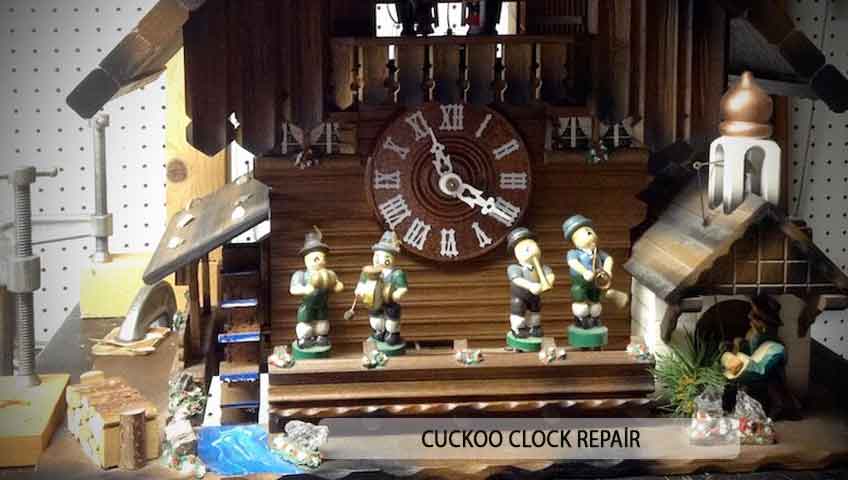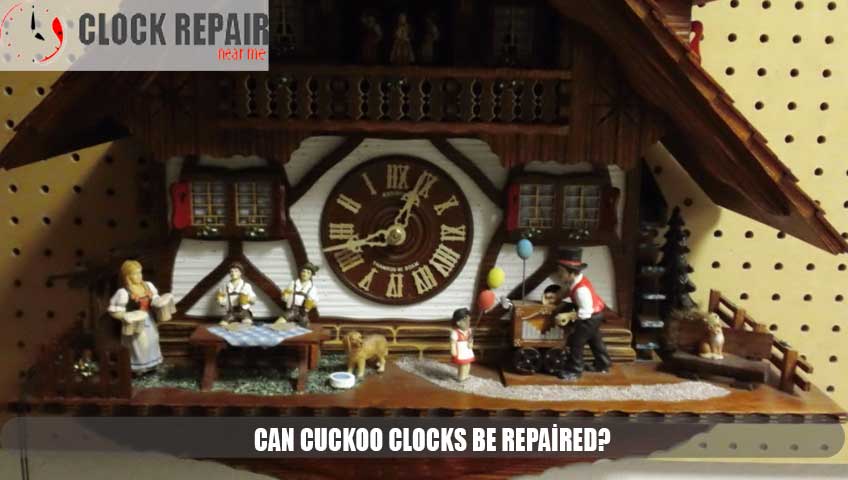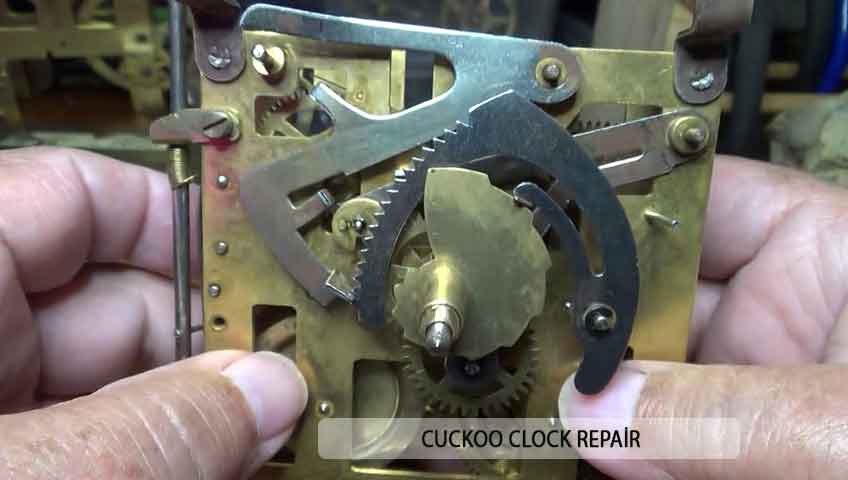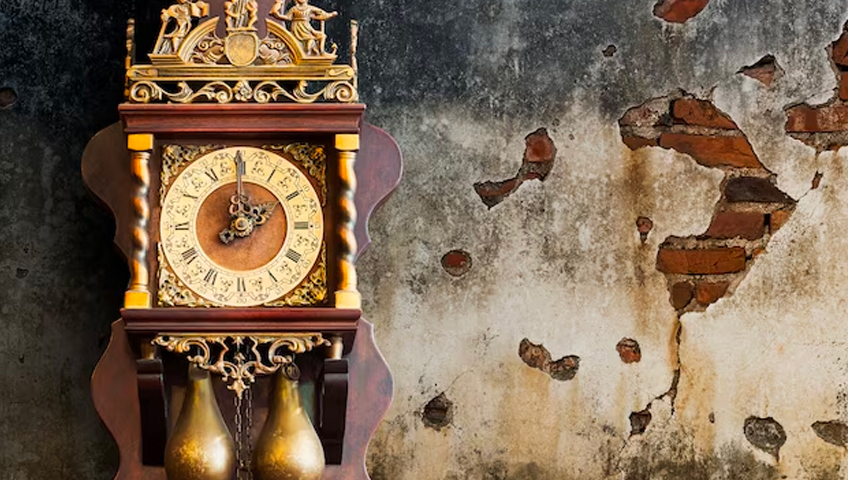Repairing a cuckoo clock can be a delicate process, and it’s important to handle the clock with care. Here are some general steps you can follow if you’re looking to repair a cuckoo clock:
Repairing a cuckoo clock can be a delicate process, and it’s important to handle the clock with care. Here are some general steps you can follow if you’re looking to repair a cuckoo clock:
- Identify the Problem:
- Examine the cuckoo clock carefully to identify the specific issues. Note any visible damage or irregularities.
- Stop the Clock:
- If the cuckoo clock is still running, stop it to prevent any further damage during the repair process.
- Remove the Pendulum:
- Take off the pendulum before you begin any repair work. This is usually done by gently lifting it off the hook.
- Inspect the Chains:
- Check the chains that control the weights. Make sure they are properly connected and not tangled. If there are any broken or damaged chains, they may need to be replaced.
- Examine the Weights:
- Inspect the weights to ensure they are securely attached. If a weight is loose or detached, it can affect the clock’s operation.
- Check the Cuckoo Bird:
- If the cuckoo bird is not emerging or is not functioning correctly, inspect the bellows and whistles. They may need cleaning or replacement.
- Inspect the Movement:
- Carefully examine the clock movement for any debris or obstructions. If there is dust or dirt, use a soft brush or compressed air to clean it.
- Oil the Clock:
- Lubricate the moving parts of the clock with clock oil. Be cautious not to over-oil, as excess oil can attract dust and cause other issues.
- Test the Clock:
- After addressing specific issues, test the clock to see if it’s functioning correctly. Check for accurate timekeeping and proper cuckoo calls.
- Adjust the Hands:
- If the clock is not keeping the correct time, you may need to adjust the hands. Use gentle pressure to move them to the correct position.
- Seek Professional Help:
- If you’re uncomfortable or unsure about any aspect of the repair, consider seeking help from a professional clock repair person. Cuckoo clocks can be intricate, and mishandling them may lead to further damage.

To serve you better and help you fix your cuckoo clocks at home, we have provided answers to frequently asked clock repair questions below. If you cannot find the answer to your clock repair question below, we are happy to offer our Tech Time consulting service. Tech Time can be purchased for $1 per 15-minute block. To make a consultation appointment or for any other questions regarding clock parts or clock repair.
Frequently Asked Questions and Answers: Fix Your Cuckoo Clock at Home
“My cuckoo clock is not working after unboxing or repairing.”
First, make sure all packaging materials are removed from the clock. Specifically, check the items listed below:
- Bellows clips (usually 2 bright orange clips)
- Remove the piece of paper from the gong on the back panel
- Move the wire latch on the cuckoo door to the side so that the door can open freely (Do not remove the latch, just slide it to the side)
- Remove the wire holding the chains at the bottom of the clock.
When the weights are on the clock, start swinging the pendulum. Move the minute hand towards the next half hour to hear the cuckoo sound. Listen for an even tik tok sound. The bottom of the case may need to be tilted slightly to the left or right until an even tick-tok sound is achieved.
Here are a few helpful tips for setting your cuckoo clock:
- Cuckoo clocks don’t necessarily have to be perfectly level to work.
- Make sure the clock is not tilted forward; must be flat (flat) to the wall
- If there is no ticking, remove the weights and the pendulum and make sure the chain is fully on the wheel. If not, rebuild the chain properly
- Ceiling fans, open windows, and floor vents will keep the pendulum from swinging.
My 5-year-old clock has stopped or isn’t ringing correctly. Why?
If your cuckoo clock has stopped ringing or is not ringing correctly, it is most likely due to lack of maintenance. Most clock manufacturers recommend lubricating a clock every year. While this is very good practice, if done right an hour can usually last 2 to 3 years between lubrications.
Petroleum oil was developed when whale oil for clocks was banned after 1980. This oil works great, but unlike whale oil, petroleum oil evaporates. After 3 years, oil residues and airborne dust remain. This trapped residue will corrode the spindles and bearing surfaces of the clockg. Therefore, the clock often stops working due to lack of lubrication or worn parts. Below is a guide for refilling worn shaft holes on your clock.
How do I use a clock lubrication kit?
Lubricating your clock is an integral part of extending its life. In general, good, quality lubrication takes about 2 to 3 years, requiring regular maintenance. Be careful when lubricating your clock as only a small amount of oil is required to do the job. In fact, using too much oil can actually damage your clock and cause premature clock failure. Below is a guide to help you lubricate your clock at home.
How do I change the chains on my cuckoo clock?
If the chain is still on the clock: To change the chain, start at the end of the hook and open the link, remove the hook and attach the new chain to the old chain. Feed the chain by winding the clock as usual. After the new one has passed the hour, remove the old chain and place the chain hook and loop on the new chain.
If the chain is outside the clock: Hold the clock upside down and thread the chain through the hole in the bottom of the clock . Run the chain over the sprocket using your finger to rotate the sprocket. Keep turning the gear as you turn the clock upright.
I broke one of my cuckoo clock’s arms. What should I do?
If you broke one of the arms of your cuckoo clock, first remove the nut holding the handles. Remove your hands and note whether the center shaft holding the longer minute hand is round or square. Also pay attention to the position of the hands.
Second, measure the length of the minute hand. If the pointer breaks, measure from the center shaft to the outer edge of the dial; this will determine the size of the hands.
Third, place the new hands on the clock, making sure to place the hour and then the minute hands. Re-tighten the hand nut using the appropriate hand nut set.
How do I replace the bellows covers of my cuckoo clock?
To replace the bellows tops on your cuckoo clock, remove the bellows whistles inside the cuckoo clock. It’s best to blow a whistle one at a time to avoid confusion. Note and mark the bellows for left and right for placement.
Transfer all hooks and wires from the old bellows to the new bellows. Gently remove the bellows top from the whistle and remove any remaining adhesive from the whistle. Attach the new bellows to the whistle (hot glue is best for this) and note the 1/4″ holes on the different sides of the bellows. Be sure to match the new bellows with the old bellows.
How do I set the time on my cuckoo clock?
Setting the time on your cuckoo clock is pretty simple. Below is an illustrated diagram to help you adjust the minute and hour hands of your cuckoo clock, loosen and tighten the hand nut, and configure the pendulum leaf.
How do I fix my clock when it’s not running? How do I troubleshoot?
To fix your cuckoo clock when it is not running, or not running properly, we have listed some tips for troubleshooting the problem at home:
- If you place the clock near open windows, fans, doors or heating vents, the clock may stop periodically due to drafts.
- If the clock is not working, set the minute hand back half an hour from the clock and leave it to the cuckoo. Adjust the pendulum to swing again.
- If the clock doesn’t work, fully wind the weights and check the chains for kinks that could prevent the weights from coming down properly.
- If you put the clock on the wall and the cuckoo isn’t playing or the jukebox isn’t playing the melody, check to see if there’s a metal lever on the side of the clock. The lever can be turned to the “off” position.
- Ignore the sticker that tells you which way to move the lever to turn the music and the cuckoo on and off. Sometimes these stickers are incorrectly translated from German, so it’s best to try both ways. The lever should be moved to one end or the other. If it is put in the middle of the two ends, there may be a problem.
- Listen to make sure the clock is working evenly, tilt the clock slightly to the left or right to get an even click.
- Look through the hole in the rear access cover of the clock to adjust the gong sound. The hammer can be bent a little closer or further away from the gong to produce the desired gong sound.
How do I set up and operate my quartz cuckoo clock?
Setting up your quartz cuckoo clock requires some special maneuvers, but novice clock enthusiasts should not be discouraged. It’s pretty simple using the following steps:
- Turn the minute hand clockwise until it shows 12 o’clock
- Open the back cover and insert two (three for musical clocks) batteries (usually C-Cell). Pay close attention to the + and – points of the battery placement
- Hang the clock on the wall and hang the pendulum
- Turn the minute hand clockwise, round and round until the clock shows the correct time.
It is important that you allow the cuckoo to attack every hour before moving on to the next hour.
If the time shown on the clock does not correspond to the number of cuckoo beats, you can troubleshoot the problem using the following tips:
- Press the “Push” button to advance the cuckoo call forward one hour. For example, if the cuckoo strikes twice, move the hand to position II (or 2 o’clock).
- On the right side of the clock you can find a switch for the volume: “max”, “min” and “off”
- There is a light sensor that automatically turns off the cuckoo when the room is dark.
- If the cuckoo’s door no longer opens and closes or the clock is slow, the batteries should be replaced.







